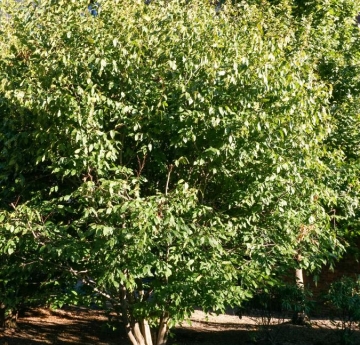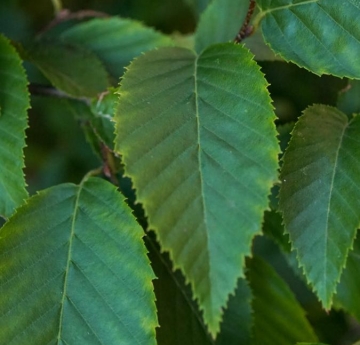Scientific name: Carpinus caroliniana
Common name: American hornbeam
Native: Yes
Native range: Native to the majority of the eastern United States, as well as some parts of southeastern Canada [1,4].
Distribution in North America: Click to view the USDA Plants Database page for C. caroliniana.
USDA Zones: 3-9A [3]
Maximum age: On average, American hornbeam lives to 100 years, but may live as long as 150 years [6].
Ecology: Birds, foxes, and gray squirrels forage the seeds, catkins, and buds, while deer, cottontails, and beaver browse the stems [1,2,3,4]. Beavers also frequently use this tree while making their dens, as it is typically abundant in their habitats [1,2,3,4]. Its foliage hosts the larvae of a diversity of butterfly and moth species, including the charismatic Io moth [7].
Ethnobotany: Although the wood is exceptionally hard, the tree is typically too small to provide useful lumber [1,3,4]. Indigenous American groups use the bark and roots for various medical applications [5].
In Defense of Plants: The Sinewy American Hornbeam
Native American Ethnobotany Database: Carpinus caroliniana Walt.
USDA: American Hornbeam Plant Fact Sheet
USDA: American Hornbeam Plant Guide
US Forest Service: American Hornbeam
Why the Best Trees Aren’t Always the Biggest by Margaret Roach for The New York Times
[1] https://plants.usda.gov/DocumentLibrary/factsheet/
[2] https://plants.usda.gov/DocumentLibrary/plantguide/
[3] http://hort.ufl.edu/database/documents/pdf/
[4] https://www.srs.fs.usda.gov/pubs/misc/
ag_654/volume_2/carpinus/caroliniana.htm
[5] http://naeb.brit.org/uses/species/758/
[6] https://www.nrs.fs.fed.us/atlas/tree/lhdr_391.html
[7] https://www.nhm.ac.uk/our-science/data/hostplants/search/list.dsml?&PGenus=Carpinus&sort=Family




